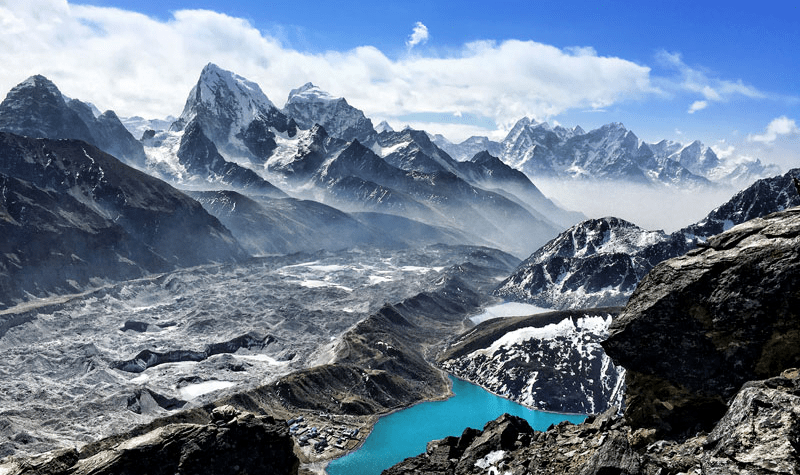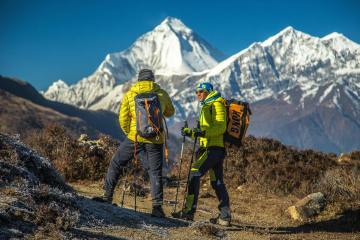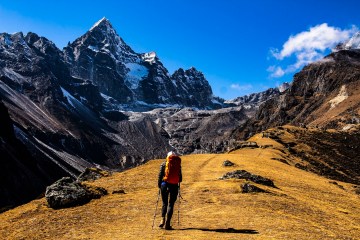Nepal, renowned worldwide for its stunning Himalayan peaks, also boasts some of the most spectacular lakes. From serene waters nestled among towering mountains to culturally significant pilgrimage sites, the lakes in Nepal offer diverse experiences. This blog explores the top 10 biggest lakes in Nepal, not just in terms of size but also their ecological, spiritual, and recreational value.
1. Rara Lake
- Location: Mugu and Jumla Districts, Karnali Province
- Altitude: 2,990 meters
- Area: 10.4 km²
Rara Lake is the largest and deepest freshwater lake in Nepal. Nestled within Rara National Park, it is often referred to as the ‘Queen of Lakes’. The lake is surrounded by alpine meadows and pine forests and supports a wide range of flora and fauna, including the endangered red panda and musk deer. The lake changes color from turquoise blue to deep navy depending on the light, weather, and season. The Rara trek is moderately challenging and offers panoramic views, making it a perfect off-the-beaten-path adventure.
2. Tilicho Lake
- Location: Manang District, Gandaki Province
- Altitude: 4,919 meters
- Area: 4.8 km²
Recognized as one of the highest lakes in the world, Tilicho Lake lies in the Annapurna range and is a highlight of the Annapurna Circuit trek. Despite its high elevation, Tilicho remains unfrozen in the warmer months, reflecting the surrounding snow-capped peaks. The hike to Tilicho Lake is rugged and demanding, often requiring acclimatization. Its remote setting, dramatic cliffs, and spiritual aura make it a bucket-list destination for seasoned trekkers.
3. Shey Phoksundo Lake
- Location: Dolpa District, Karnali Province
- Altitude: 3,589 meters
- Area: 4.94 km²
Shey Phoksundo Lake is famous for its unreal turquoise color and incredible clarity. Located in Shey Phoksundo National Park, it is regarded as sacred by the local Tibetan Buddhist community. There are no aquatic life forms due to the lake’s high mineral content, but the surroundings are rich in wildlife like blue sheep and snow leopards. The traditional villages and ancient monasteries, like Tshowa Gompa, add depth to the spiritual landscape.
4. Gosaikunda Lake
- Location: Rasuwa District, Bagmati Province
- Altitude: 4,380 meters
- Area: 13.8 hectares
Gosaikunda is a revered alpine lake associated with Hindu mythology. It is believed to have been formed by Lord Shiva to cool his throat after consuming poison. Each year, thousands of Hindu and Buddhist pilgrims visit during Janai Purnima, braving the rugged Langtang National Park trail. The lake is surrounded by other smaller lakes, and the area turns into a pilgrimage hub in August. The trek to Gosaikunda is scenic, passing through rhododendron forests and traditional Tamang villages.
5. Gokyo Lakes
- Location: Solukhumbu District, Sagarmatha Zone
- Altitude: 4,700–5,000 meters
The Gokyo Lakes system comprises six main glacial lakes and is the highest freshwater lake system in the world. Located in Sagarmatha National Park, a UNESCO World Heritage Site, they are fed by glaciers from Everest and surrounding peaks. The Gokyo Ri viewpoint offers one of the best panoramic vistas of Everest, Lhotse, Makalu, and Cho Oyu. Pilgrims, especially Hindus and Buddhists, consider these lakes sacred, and festivals are occasionally held here in August.
6. Phewa Lake
- Location: Pokhara, Kaski District
- Altitude: 742 meters
- Area: 4.43 km²
Phewa Lake is a popular tourist destination and a major landmark in Pokhara. It offers stunning reflections of the Annapurna range and is home to Tal Barahi Temple located on an island in the lake. The area around the lake is vibrant with restaurants, cafes, and shops. Visitors can enjoy rowing, kayaking, and paragliding. The lake also supports fish farming and sustains the local economy. The lakeside area is ideal for relaxed leisure travel.
7. Begnas Lake
- Location: Pokhara, Kaski District
- Area: 3.73 km²
Less commercial than Phewa, Begnas Lake is a haven for those seeking peace and natural beauty. Surrounded by lush hills, it is ideal for meditation, fishing, and boating. The lake supports traditional irrigation systems and local aquaculture. Tourists often choose Begnas for wellness retreats and quiet escapes, with numerous lodges and homestays offering yoga and organic meals.
8. Rupa Lake
- Location: Pokhara, Kaski District
- Area: 1.35 km²
Located near Begnas Lake, Rupa Lake is a serene, lesser-known destination perfect for birdwatchers and nature lovers. It hosts numerous bird species, including migratory ones during winter. The lake is used for both aquaculture and irrigation, and its proximity to forested hills makes it a tranquil spot for picnics and light treks. Local community-based conservation efforts are also notable here.
9. Ghodaghodi Lake
- Location: Kailali District, Sudurpashchim Province
- Altitude: 205 meters
- Area: 2.56 km²
Ghodaghodi Lake is a natural wetland complex comprising several lakes and ponds. Recognized as a Ramsar site, it supports a wide range of biodiversity including endangered species like the Bengal florican and smooth-coated otter. The lake is also culturally significant, with temples and shrines dedicated to local deities. Located near the East-West Highway, it is accessible and a great destination for eco-tourism and environmental education.
10. Birendra Lake
- Location: Gorkha District, Gandaki Province
- Altitude: 3,691 meters
Formed by the Manaslu glacier, Birendra Lake lies near the base of Mt. Manaslu. It is a glacial lake with a calm surface that reflects the rugged snow-covered peaks. Trekkers often stop here while on the Manaslu Circuit for rest and photography. The peaceful ambiance and the echo of avalanches from nearby slopes provide a surreal experience. Due to its elevation and climate, the lake often freezes during the winter.
Conclusion
Nepal’s lakes are not just bodies of water; they are reservoirs of biodiversity, culture, adventure, and spiritual significance. From the highest altitudes to the lush lowlands, each lake tells a unique story. Whether you’re seeking peace, pilgrimage, or panorama, Nepal’s lakes promise unforgettable memories. Plan your journey with respect for the local environment and communities to ensure these natural wonders thrive for generations.
Discover more from Nepal Travel Vibes
Subscribe to get the latest posts sent to your email.



